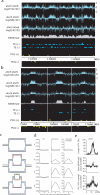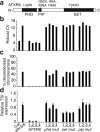Regulation of heterochromatic DNA replication by histone H3 lysine 27 methyltransferases
- PMID: 20631708
- PMCID: PMC2964344
- DOI: 10.1038/nature09290
Regulation of heterochromatic DNA replication by histone H3 lysine 27 methyltransferases
Abstract
Multiple pathways prevent DNA replication from occurring more than once per cell cycle. These pathways block re-replication by strictly controlling the activity of pre-replication complexes, which assemble at specific sites in the genome called origins. Here we show that mutations in the homologous histone 3 lysine 27 (H3K27) monomethyltransferases, ARABIDOPSIS TRITHORAX-RELATED PROTEIN5 (ATXR5) and ATXR6, lead to re-replication of specific genomic locations. Most of these locations correspond to transposons and other repetitive and silent elements of the Arabidopsis genome. These sites also correspond to high levels of H3K27 monomethylation, and mutation of the catalytic SET domain is sufficient to cause the re-replication defect. Mutation of ATXR5 and ATXR6 also causes upregulation of transposon expression and has pleiotropic effects on plant development. These results uncover a novel pathway that prevents over-replication of heterochromatin in Arabidopsis.
Figures




References
Publication types
MeSH terms
Substances
Associated data
- Actions
- Actions
Grants and funding
LinkOut - more resources
Full Text Sources
Other Literature Sources
Molecular Biology Databases

